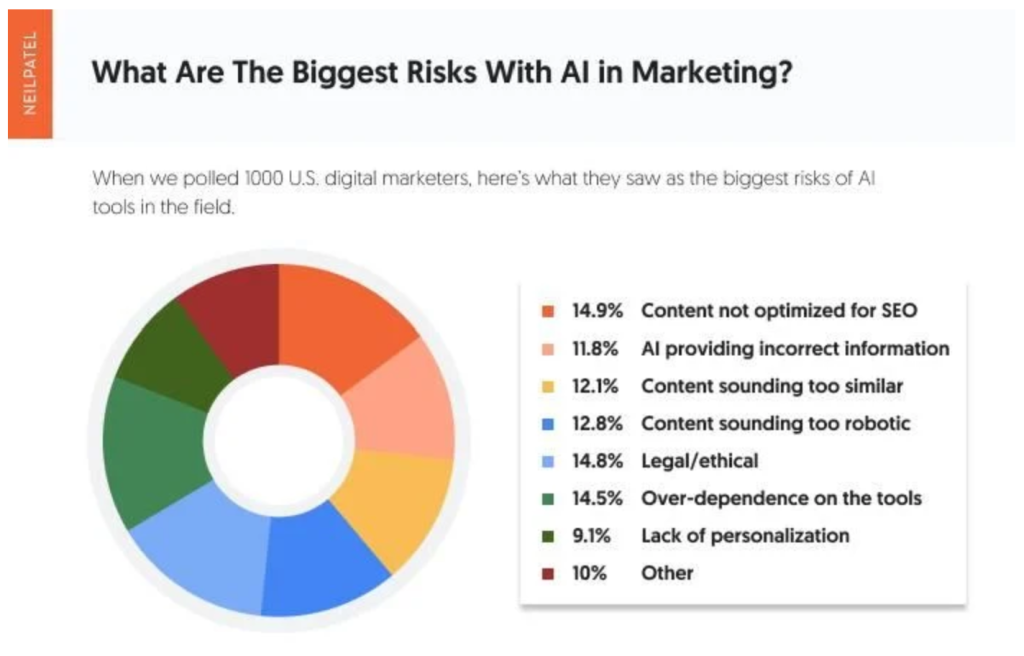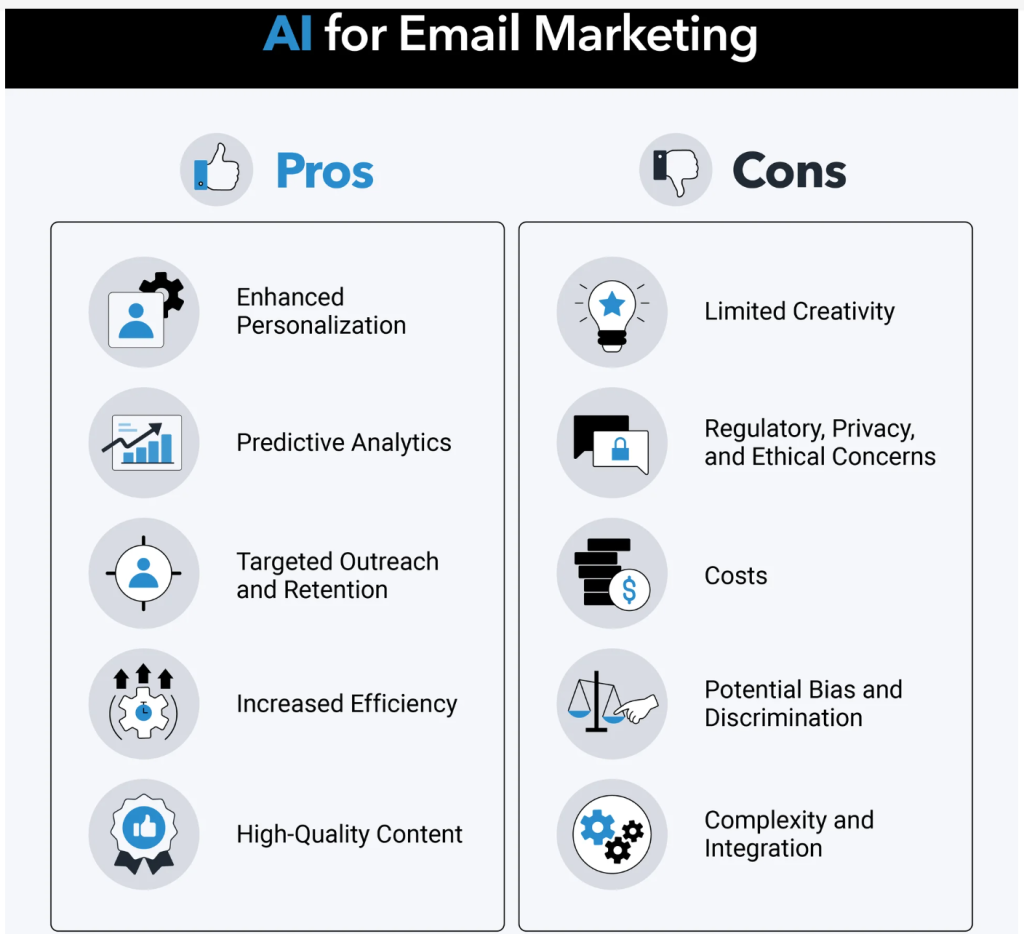- Home
- Friday Column
- AI in Email Marketing: What Ca ...

✨ Key takeaways:
⭐ AI delivers clear benefits but also introduces new risks for email marketing.
⭐ Over-personalization can alienate customers instead of engaging them.
⭐ Poor or biased data leads to irrelevant targeting and campaigns that ignore context.
⭐ AI-generated content can dilute brand voice and produce generic messaging.
⭐ Overreliance on automation and AI tools risks skill loss and reduced critical oversight.
⭐ Legal compliance and data privacy remain essential to avoid reputational and financial damage.
Personalization, automation, less effort, and more free time—the arrival of AI in email marketing may sound like a blessing for many specialists working in this industry. And in many ways, it is. Nonetheless, as the old saying goes, free cheese is only in a mousetrap. AI has entered our professional lives carrying certain negative aspects as well. For better or for worse, it is not yet a cure-all.
While providing us with undeniably powerful features, AI inevitably brings its own set of disadvantages. These can range from the gradual loss of essential skills to an inability to fully grasp context to overreliance on automated processes that make campaigns less individualistic and more generic. In this article, we will take a closer look at these hidden pitfalls and see how, alongside its many benefits, AI in marketing can sometimes work against the very goals it’s meant to achieve.
AI Email Personalization Gone Wrong—When Messaging Misses the Mark
Personalization is often seen as one of the most promising capabilities of AI in marketing. And it makes total sense, since it offers the potential to make every communication sound like it was made for us and us alone. This is an ideal scenario that does not consider possible bumps along the way of a marketing campaign. In practice, however, implementation of personalization in AI-driven email campaigns produces results that sometimes deviate from these idealistic expectations. So, how can AI personalization in marketing go wrong?
Overpersonalization can seem creepy
Personalization can be addictive, as there’s always a temptation to add one more detail that will please a customer a bit more. While the use of AI in marketing enables the processing of vast amounts of behavioral and transactional data, the resulting precision can occasionally cross a psychological threshold for the recipient. Emails that reference recently viewed products with excessive specificity or highlight personal details drawn from indirect data sources may be perceived as invasive. This effect is often amplified when AI in marketing automation operates without sufficient consideration of user consent—and that’s when we step into even more dangerous territory of the data privacy breach.
Misjudged tone in AI-generated subject lines or body copy
Generative AI in marketing tools is capable of creating subject lines and body copy at scale, which is a huge plus. What makes this “mass production” dangerous is the fact that AI relies heavily on training data and programmed objectives. When these inputs fail to capture subtle cultural aspects or the emotional context of a campaign, the outcome may be stylistically correct but feel contextually off. Like this, we get unintended humor in a serious announcement or phrasing that sounds too casual for a formal communication.
Product recommendations based on flawed or limited behavioral data
Finally, and that is a big one, we have AI-generated product recommendations that are based on flawed or incomplete behavioral datasets. In such cases, using AI for marketing may result in suggestions that are irrelevant or ill-timed. Examples of personalization that is based on the wrong data might include promoting seasonal products to customers in incompatible climate zones or advertising items that the recipient has already purchased or returned. Such missteps are poorly tolerated by customers and often lead to loss of interest towards a brand.
AI functionalities in email marketing

Bad Data, Bad Decisions—How AI Email Marketing Tools Can Backfire
There cannot be a second opinion about the fact that data is the backbone of AI in marketing. Without it, algorithms have nothing to analyze and no predictions to make. But while we often talk about the power of data, we don’t always acknowledge the other side of the equation: bad data are just as powerful, just not in a good way.
Irrelevant email targeting
AI in marketing automation depends on accurate, up-to-date information to determine who should receive which message and when. When that information is inaccurate, the results can range from mildly annoying to brand-damaging. Just imagine the reaction of a cat lover to an email campaign promoting products for dogs, and you’ll get the scale of this disaster.
Reinforced stereotypes in product segmentation
Another issue emerges when biased or incomplete datasets lead generative AI in marketing systems to reinforce stereotypes. For example, algorithms may decide that certain products are “better suited” for one demographic over another based purely on historical sales data. What it does not take into account are changes in cultural trends or customer individuality. Such rigid segmentation limits opportunities for the brand. What’s worse, it can also alienate customers who don’t fit the algorithm’s outdated profile.
Lack of contextual awareness from rigid machine learning rules
Machine learning models are excellent at recognizing patterns, but they struggle to interpret sudden changes in customer behavior caused by unique events. Without human oversight, AI and marketing tools can send entirely tone-deaf campaigns during sensitive periods or promote items during stock shortages. This mismatch between the brand’s message and the customer’s reality can be harsh on the customer’s perception and the brand’s reputation alike.

Can AI-Generated Content Feel Human? A Creative Dilemma
AI in marketing has transformed how quickly and efficiently email campaigns can be produced. There can be no doubt about that! But while it is hard to compete with ChatGPT in speed of writing, the creative trade-off that comes with automation is still there. What happens when AI-generated content misses one crucial part—human voice? Let’s break it down.
Emails that sound robotic or generic
Even the most advanced AI generative models still do not write like humans and default to predictable language patterns. As a result, we get a copy that is technically correct but that feels generic and definitely lacks those language subtleties that make it alive.
Brand voice dilution
When using AI for marketing, the temptation to automate all copywriting can be very strong. In the end, it can spare us so much time and effort! However, removing too much human input can slowly dilute a brand’s personality. If you had a unique voice and style, an abrupt switch to AI writing can alienate people and turn you into a stranger even for your loyal clients.
Cookie-cutter content from similar tools
Many brands use the same AI automation tools, trained on overlapping datasets. This creates a problem of “sameness.” Suddenly readers stumble upon similar phrases and subject lines no matter which email they open, while brands start losing themselves in a sea of near-identical messaging.
Email Automation Disasters—When AI Triggers Go Off-Script
For email marketing, automation is without any doubt one of the most significant features in the entire delivery process. Its ability to send a vast number of emails in a short time tremendously reduces manual effort while still maintaining quality. At the same time, this very same capability can introduce vulnerabilities. As with any automated process, there is always the possibility that it will deviate from intended parameters. What happens then?
Misfires in send times and message frequency
AI in marketing automation relies on behavioral and demographic data to schedule delivery. In theory, this should ensure that every message arrives at the right time. In practice, without proper oversight, the system can produce glitches—sending late-night emails or multiple messages to the same recipient within a short time frame. Whether such incidents happen often or not is almost beside the point, as even a single poorly timed send can leave a negative impression, shaping how customers perceive the business.
Rigidity of trigger-based workflows
Triggered campaigns respond to predefined customer actions, and on paper this seems perfectly logical. However, it’s important to always keep context in mind. While there may be a pattern in these behaviors, there are always individual situations that don’t fit the pattern. In such cases, what works for the majority may fail for a particular customer. Sometimes this is the result of simple glitches, but often it’s a lack of context.
Over-automation of nurture flows
Automation can streamline operations, no doubt about it. But when we overrely on it without any adaptive oversight, the tone of communication inevitably changes. Conversations stop sounding human, and customers feel it. People tend to disengage when interactions feel overly mechanical — especially if this happens on a regular basis.

Overreliance on AI Email Marketing Tools — A Dangerous Comfort Zone
It’s important to remember that AI email tools in marketing were created first and foremost to take some of the load off human shoulders and free them up for more important tasks. Unfortunately, because these tools make processes so much easier for us, our brains naturally tend to gravitate toward activities that require less effort. As a result, we stop treating AI as a helper and start treating it as a substitute for our own work.
This, sadly but inevitably, leads to certain problems, such as skill loss. Over time, it can start to feel impossible to produce a text entirely on your own without first seeing an AI-generated draft. You begin to overlook mistakes, lose your feel for tone, or simply stop practicing the skills you once relied on. The same applies when we put blind trust in A/B testing or algorithmic predictions—accepting results without question rather than critically evaluating them.
Legal & Ethical Pitfalls in AI Email Campaigns
Finally, last but not least, when it comes to AI, consent remains a major concern. Under regulations like the GDPR and CCPA, collecting and processing personal data for AI in marketing automation requires explicit user permission. Nonetheless, in the rush of personalization, some systems blur or even ignore this boundary. When it comes to personalization, it is crucial to remember that AI in marketing always has to be done with legal compliance in mind.
Another potential risk of using generative AI in marketing is related to so-called “hallucinations”—a phenomenon when content produced by AI is not entirely accurate. This calls to a common mistake of overreliance on AI without fact-checking, leading to various errors from inaccurate product claims to promotions for items that don’t exist. Such errors, especially at scale, can lead to financial and reputational risks for companies and failed customer experiences.
To Sum Up
AI is here to stay—and that is good news. It already brings us countless benefits across all areas of life, email marketing included. The key, as with anything else, is to approach it mindfully.
If we want AI to bring us more advantages than drawbacks, we need to balance the capabilities it offers with our own. Our skills, intuition, and understanding of context are substantial assets—ones we have invested years of time and effort to develop. By combining these strengths with the advantages of AI, we can enjoy all the benefits it provides to marketing while ensuring we don’t lose the value and expertise that make our work truly our own.



